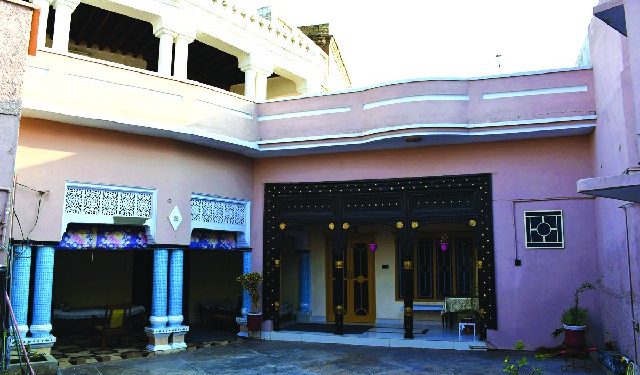
Pindigheb rose to prominence during the British Raj. Many administrative buildings were built by the British officials in the town.
Apart from the temples, Hindus of Pindigheb built impressive Samadhis of ascetics whom they also venerated.
Zulfiqar Ali Kalhoro
Pindigheb is a tehsil and historic town in the Attock district. Like many other towns in Attock, Pindigheb is also home to several historic buildings which were mostly built during the British Raj. The town of Pindigheb is located about 35 km from Mithial chowk.
Located on the south of Sil River, the town rose to prominence during the British Raj in Punjab. According to the Gazetteer of the District Attock, Pindigheb was the ancestral seat of the Jodhra Maliks, whose ancestors laid the foundation of the town. The Jodhras claim Rajput descent and their ancestor was converted to Islam by Mahmud of Ghazni, who was settled in Jammu. Later, they migrated to the Sil valley and founded Pindigheb. In the 16th century, the Jodhras extended their power between Soan and Sil valleys, the most fertile and prosperous area in Attock and Chakwal districts. They were known as the lords of Soan and Sil valleys and their power was also recognized by the Mughals. The first powerful Malik of the Jodhra tribe was Malik Aulia Khan who also held a revenue assignment of Pindigheb, Talagang, and parts of Chakwal and Fateh Jang for the Mughals.
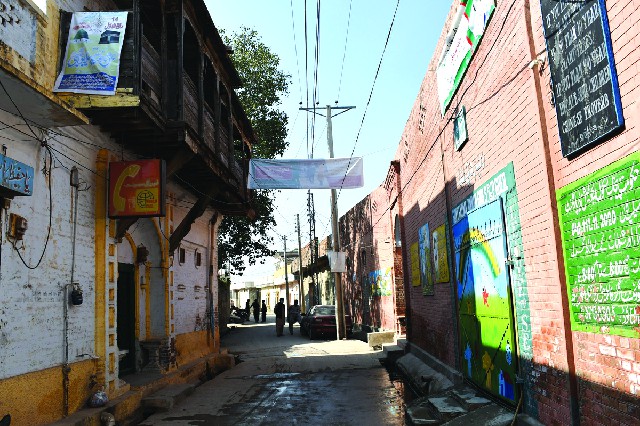
Later his son Malik Amant Khan also became powerful lord of Sil and Soan valleys. According to Gazetteer of the District Attock, with the rise of Ghebas, the power of Jodhras declined. The Ghebas snatched the main areas where once Jodhras held sway. There are still many oral historians and village intellectuals in Pindigheb tehsil who narrate the heroics of the noblemen of Jodhras and various branches of the tribe.
Pindigheb rose to prominence during the British Raj. Many administrative buildings were built by the British officials in the town. The town had also impressive mansions of both Jodhras Maliks and Gheba Mlaiks. Both Jodhras and Ghebas are still the nobility of the town. The mansions of Jodhras and Ghebas still break the skyline of the town.
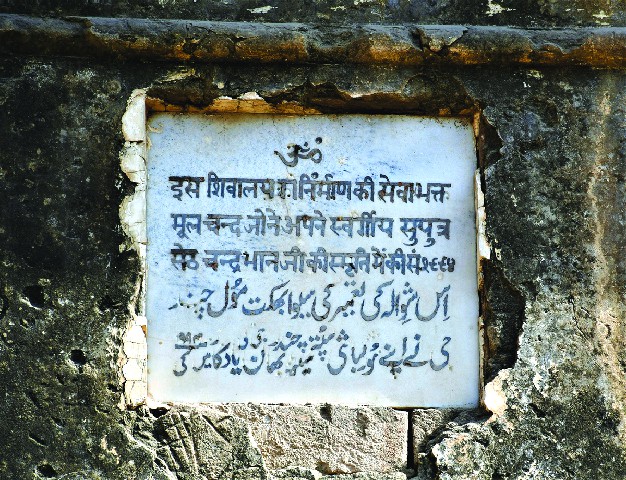
The haveli of Haji Malik Jang Bahadur Khan is the most imposing structure in Pindigheb town, which was built in 1895 as per an inscription on the main entrance of the haveli. The portico of the haveli has a majestic look with a wooden door enclosed in a wooden arch. The wooden windows above the door also give a pleasing look to the portico of the haveli. It was later renovated by Malik Nisar Khan. Close to this haveli is bethak (guest house) also called haveli of Malik Aamir Khan which is also a magnificent building. It is also an old structure which is noted for beautiful columns and wooden doors and ceilings. These grand structures of Maliks of Pindigheb are potent political symbols of how they once held sway not only in Pindigheb but also in parts of Fateh Jang and Talagang tehsils in the British Raj. The great Ghebas are still a powerful tribe in Pindigheb and Fateh Jang tehsils of the Attock district.
Apart from Muslim mansions in Pindigheb, the Hindu merchants also built imposing havelis which are located in different mohallas of the town. The most beautiful havelis and temples were located in Jamia Madina Masjid locality. In one of the streets of this locality are found two temples. The first temple bears inscriptions in Urdu and Gurmukhi. According to the inscription on the façade of a temple, it was built by Bhagat Mulchand in memory of his son Seth Chandarji Bhan in Vikram Samvat (Hindu calendar) 1994 which corresponds to 1937 on the Gregorian calendar. It is a small shivala ( Shiva temple) with a square garbhagriha (inner sanctum) for placing the image of Shiva. The garbhagriha is crowned with an octagonal shikhara. The second temple is located opposite the first one. This temple has also a square garbhagriha with an octagonal shikhara. Both temples now lie in dilapidated condition. There is also a third temple in Pindigheb town where currently a Muslim family lives there.
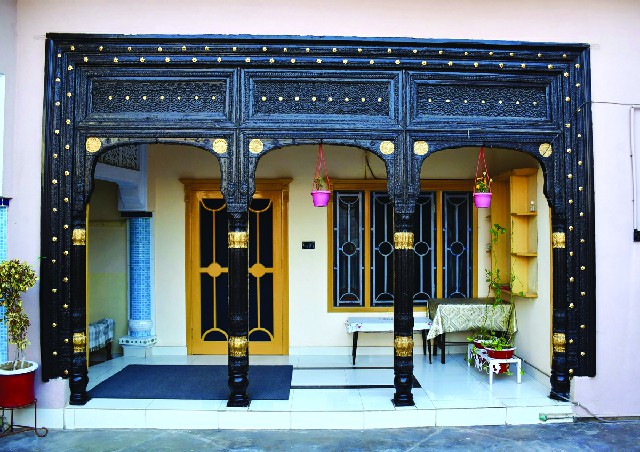
Apart from the temples, Hindus of Pindigheb built impressive Samadhis of ascetics whom they also venerated. The remains of one of the Samadhis are located in the premises of Fatima Jinnah Girls High School in Pindigheb. Only the southern walls of the Samadhi are only extant now. It was formerly located inside the enclosure, the remains of which can still be seen. The debris of the fallen walls of Samadhi and the enclosure are found at the site.
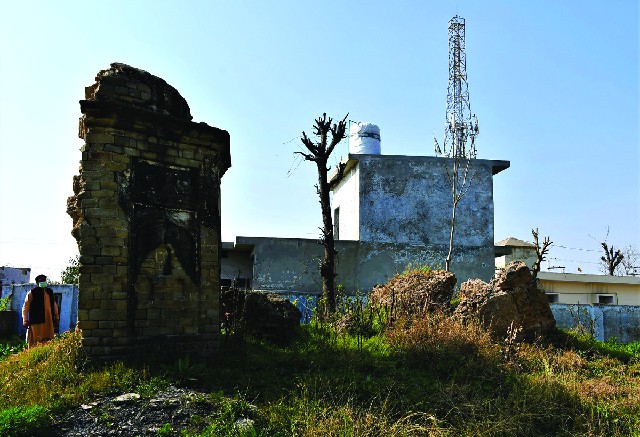
From the remains of the Samadhi, one can reconstruct its architecture. It was an octagonal Samadhi with a hemispherical dome, a fragment of which is still intact. The interior of the Samadhi was painted, traces of which can still be seen on the remaining walls. From the remains of Samadhi, one can have a view of the spire of St. Mary’s Catholic Church, which is located behind the school building.
The Hindus of Pindigheb were traders and they had businesses in major towns and cities of Punjab. Hindus had shops in the main bazaar of the town. In the narrow streets of Pindigheb town, porticoes of havelis provide a historical vista of the town. Both Muslims and Hindus of the town lavishly spent on the porticoes of their havelis which reflected their political and economic power. There is a possibility that some of the porticoes also depicted the images of Hindu deities but at present nothing is extant. Wooden doors, which were always flanked by sitting platforms, where once the older members of the family used to sit and observe the social and economic activities in a street, also received special treatment by the builders of the havelis. Similarly, the older female members of the families used to observe street life from the jharokhas and balconies. In most of the jharokhas, three small raised platforms were made with the central one used by the most senior members of the family, followed by the juniors who used to sit on the flanking platforms.
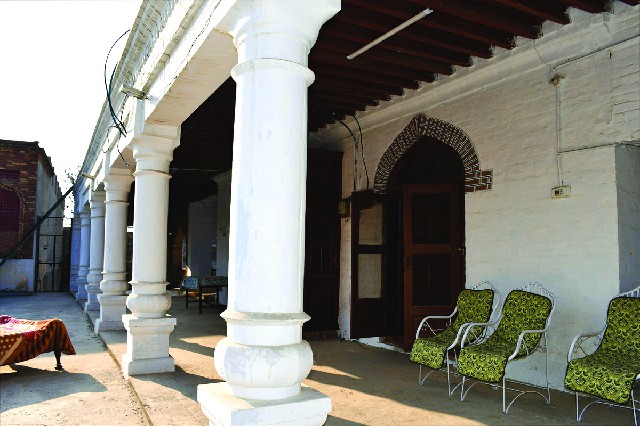
Almost every historic haveli in Pindigheb has an ornately carved wooden door that is enclosed in a brick-built rectangular frame. These brick-built rectangular frames also bear floral and geometric patterns on either side of the portico. Some of the impressive porticoes are seen in a street in Jamia Masjid Madina locality. In the same street are found two of the impressive porticoes of the Janj Ghar (marriage hall) and Boarding House respectively. Janj Ghars were found almost in every historic village and town of Pothohar in general and Attock district in particular – where the Hindu population was living. Like their havelis and temples, Hindus also lavishly spent on these Janj Ghars. The distinctive features of the Janj Ghars in Pothohar were grand main entrances, elaborately carved wooden doors, balconies and paintings.
The Janj Ghar of Pindigheb town was also noted for its imposing portico. There is an inscription on the portico which bears the name of the donor. It says that the wall and portico were donated by Lala Lakhi Chandji in memory of his father Lala Ladha Ram Suri in Vikram Samavat 1987/ 1930. Today the Janj Ghar lies in a dilapidated condition. The dome of the structure is also crumbling brick by brick. It was used as a police post for some time. Now, it is abandoned and crying out for renovation.
Near the Janj Ghar is located an old Boarding House which, as per the inscription, was built by Bhagat Mulchand Chander Bhan Anand on the 26th of January 1942. Now, this building of Bhagat Mulachand Anand is being used as Fatima Jinnah Primary Girls School. Just opposite this school is located an old haveli which is noted for its magnificent portico and wooden balcony.
Apart from Jamia Madina Masjid mohalla, there are also other localities in Pindigheb where one finds the havelis of both Muslims and Hindus. The most magnificent havelis of Hindus were found around the Chowk Kukran and included the havelis of Gian Chand, Karam Chand, Ganga Ram, Ram Rattan, Ganesh Das and others. Most of these havelis were, again, famous for woodwork. At present, wooden doors, windows and arched entrances of the havelis all retain a majestic appeal to visitors and showcase historical and cultural vistas of Pindigheb town.
__________________
 Zulfiqar Ali Kalhoro is an anthropologist and author of 12 books including ‘Symbols in Stone: The Rock Art of Sindh’, ‘Perspectives on the art and architecture of Sindh’, ‘Memorial Stones: Tharparkar’ and ‘Archaeology, Religion and Art in Sindh’. He may be contacted at: zulfi04@hotmail.com
Zulfiqar Ali Kalhoro is an anthropologist and author of 12 books including ‘Symbols in Stone: The Rock Art of Sindh’, ‘Perspectives on the art and architecture of Sindh’, ‘Memorial Stones: Tharparkar’ and ‘Archaeology, Religion and Art in Sindh’. He may be contacted at: zulfi04@hotmail.com
Courtesy: The Friday Times Lahore